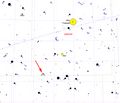NGC 2775
Appearance
| NGC 2775 | |
|---|---|
 Image derived from Hubble Space Telescope. | |
| Observation data (J2000 epoch) | |
| Constellation | Cancer |
| Right ascension | 9h 10m 20.1s[1] |
| Declination | +07° 02′ 16.6″[1] |
| Redshift | 1354 ± 5 km/s[1] |
| Distance | 55.5 Mly (17 Mpc) |
| Apparent magnitude (V) | 11.03[1] |
| Characteristics | |
| Type | SA(r)ab[1] |
| Apparent size (V) | 4′.3 × 3′.3[1] |
| Other designations | |
| UGC 4820, PGC 25861,[1] Caldwell 48 | |
NGC 2775 (also known as Caldwell 48) is an unbarred spiral galaxy with a prominent ring structure in the constellation Cancer. This galaxy has a bulge and multiple spiral arms, on which few HII regions can be detected, implying recent star formation. It was discovered by William Herschel in 1783.
NGC 2775 is the most prominent galaxy in a small galaxy group known as NGC 2775 group, part of the Virgo Supercluster, along with the Local Group. Other members of the NGC 2775 group include NGC 2777 and UGC 4781.[2]
SN1993z is the only supernova known to have occurred in NGC 2775 and was a Type Ia on Sept. 23rd that year at a magnitude of 13.9.[3] By the 25th, spectra that was obtained showed that it had peaked four weeks earlier.[4]
Gallery
-
NGC 2775 imaged with a 32-inch telescope.
-
Map showing the location of NGC 2775.
References
- ^ a b c d e f g "NASA/IPAC Extragalactic Database". Results for NGC 2775. Retrieved 2010-03-24.
- ^ "A List of Nearby Galaxy Groups". Atlas of the Universe. Retrieved 2010-11-28.
- ^ "List of Supernovae". IAU Central Bureau for Astronomical Telegrams. Retrieved 2012-01-10.
- ^ "IAUC 5870: N Lup 1993; 1993Y; 1993Z". IAU Central Bureau for Astronomical Telegrams. Retrieved 2015-11-23.
External links
- NGC 2775 on WikiSky: DSS2, SDSS, GALEX, IRAS, Hydrogen α, X-Ray, Astrophoto, Sky Map, Articles and images
- NGC 2775 at Deepskypedia


